
|   |

|   |
 e-mail: sunilkothari1933@gmail.com 5th edition of Nrityodaya's Nrityolsavam Dance Festival Photos courtesy: Nrityodaya April 10, 2019 Ayswaria Wariar is a name to reckon with in the field of Mohiniattam. She has been organizing classical dance festivals annually in Vadodara inviting dancers from different parts of the country. Trained in her childhood by her mother, she later took lessons in Kathakali under Udyogamandal Vikraman which helped her to master netrabhinaya and mukhajabhinaya. She studied further under Kalamandalam Saraswathi in Kerala. She worked with Kavalam Narayana Panicker, and learnt items based on Sopanam music as devised by Kavalam. Ayswaria has also studied Bharatanatyam under Sucheta Chapekar in Pune. Nrityodaya offers training in both Bharatanatyam and Mohiniattam. Among her other accomplishments Ayswaria has choreographed, directed and acted in Nilima, a film on Mohiniattam. Nrityolsavam took place from 22nd till 24th March at CC Mehta Hall, Vadodara. On the opening night, Aruna Mohanty presented two choreographic works: Sansara and Nayaka Pratinayaka, both choreographed by her. In Sansara, she dwelt upon the various stages of life. Ultimately it is god who gives us liberation. The four stages were enacted with consummate artistry by Aruna. From childhood pranks to young age, the feelings of love which spring between man and woman, the growth, the desire to acquire more and more of earthly material wealth and then in old age, one realizes that the only resort is that of God. Having been thoroughly groomed by Guru Gangadhar Pradhan, Aruna with her command over technique, put her best foot forward in Odissi. She presented her favourite choreographic work Nayaka Pratinayaka with libretto of poet lyricist Kedar Mishra. 'I am therefore you are' is the existential philosophy worked out taking heroes and opposites from four yugas. Her outstanding work has been reviewed by me earlier in my column. Suffice it to say that the Vadodara audience welcomed the work with great enthusiasm. Aruna spoke in the end telling the audience, 'Because you are there, I am' to applause. 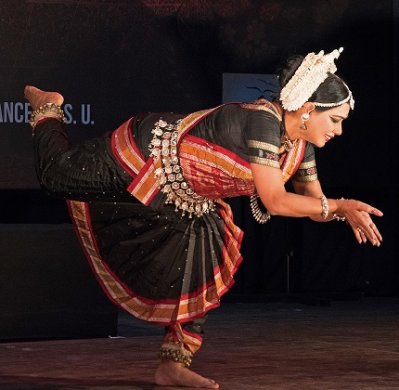 Aruna Mohanty 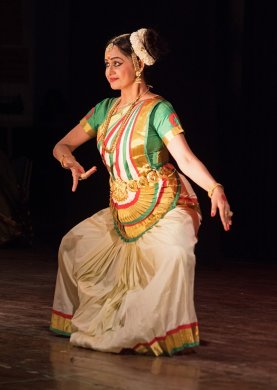 Ayswaria Wariar Ayswaria had conceptualized and choreographed Mandodari Sita based on Manoj Kuroor's text, set to music by N.N. Sivaprasad. She selected the section of Sita only titled 'Bhumiputri Sita' bringing to life the dignified Sita, following Lord Rama in all stages of his life. The story was divided into four parts as Rama and Sita's wedding, their vanavasa in forest, Ravana sending Maricha as golden deer, Sita requesting Lakshmana to go to help Rama, Ravana kidnapping Sita and keeping her in Ashokavatika as a captive. Ayswaria laid more stress on abhinaya. It would have been more effective if Ayswaria had used vaitaris, mnemonic syllables, with adavus for the transition of scenes. Then the ekaharya lasyanga abhinaya would have gained more impact. Sita says to Lakshmana that if Rama would not be alive, that very moment she would die and her dead body would be of no use to anyone. Similarly when Ravana offers her wealth, she tells him that she does not need any wealth, as she has her Lord, and if he tries to catch her, she would die and what would he do with her dead body. She would merge with Panchabhuta, the five elements. The tears that she would shed would turn into fire and the body which is destructible will merge with five elements as Lord Vishnu represents Panchabhuta. This interpretation as enacted by Ayswaria placed Sita in role of an intensely devotional wife who could not live without Lord Rama. Ayswaria's students presented Kavalam Narayana Panicker's composition Maya Mohanam in Mohana raga. Devoted to glory of Krishna the students performed various episodes like Gajendra Moksham, Draupadi Vastrapahanranam and Geetopadesham, highlighting Krishna's deeds. Vrunda Sheth, Arunima Murali, Shagun Kishen, Krishika Garg and Veena Vasudevan performed competently with graceful movements becoming the Mohiniattam form. 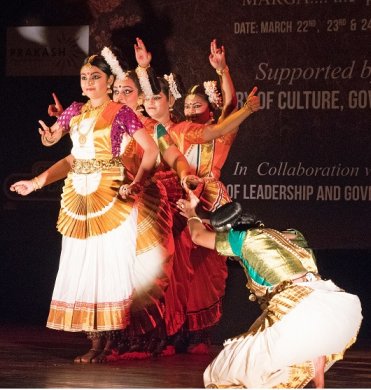 Maya Mohanam 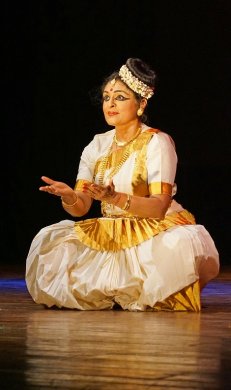 Deepti Omchery Bhalla On 23rd March, the program opened with performance of Delhi based Dr. Deepti Omchery Bhalla, the celebrated senior Mohiniattam exponent. She is currently senior professor, dean of Carnatic music faculty of Delhi University. She studied Kathakali for 12 years under various gurus including late Guru Gopinath, Sadanam Nandakumar and Sadanam Balakrishnan. She studied Mohiniattam from legendary Kalyanikutty Amma. She has co-authored with her mother Leela Omchery four books on music, has collected rare songs and set them musically with her mother. She opened her recital with Karatala Ganesh stuti in Saurashtra raga and triputa tala. A rare shloka in praise of Lord Ganapati commenced with paatakshara or vaitari on edakkya in triputa tala. The speed of rhythm played by edakkya gradually ascends from slow to fast, climaxing into crescendo. It set the mood for the items to follow. Adikeshava Nritya Prabandham set to Tukka raga and chempada tala is based on Kshetra Nritya in Sanskrit of an unknown poet. Lord Adikeshava was the family deity of Travancore Maharajas who then ruled Southern states with Padmanabhapuram as their capital. A replica of the idol at Padmanabhaswamy temple shows the lord in reclining position. The verses in rhythmical couplets or quadruplets are composed in Tarangini Nritya. Credit goes to Deepti to choreograph this unusual composition. The sancharis included few incarnations from Dashavatara. She also incorporated few movements from Arjuna Nritam. Interesting was the abhinaya to Ardhanarishwara, a rare Malayalam composition that vividly describes the Divine Hermaphrodite form of Lord Shiva and his consort Parvati with one half male and other female. This is a rare pada in comparison to Adi Shankaracharya's well known composition. Whereas Lord Shiva has crescent moon on his jata, Parvati has lovely hair decorated with flowers. Lord Shiva has three eyes, and opening the third eye he had turned Kamadeva to ashes, whereas Parvati has tilak with chandan on her forehead. Lord Shiva has around his neck serpents as garlands, Parvati has golden ear rings. Shiva has garland of skulls, and Parvati garland of pearls. For Shiva's dance the mnemonic syllables were used whereas for Parvati's dance, soft solfa tunes were employed. The devotee bows to this vision of half male and half female with wonder. Deepti brought out those images vividly. What followed was an interesting dance number choreographed in 2018 by Ayswaria based on Gujarati Charan literature titled Bherkar Bherkar Jogmaya. Like in Kathak, the poetic kavits which are recited to describe form of the God, the Charani text also follows the same format. Kainaaz Pardiwala, Ayswaria's disciple performed the Shiva Tandava with vigour. This was a welcome attempt, since Ayswaria has settled in Gujarat. It brings the local regional culture close to classical dance forms. Kainaaz performed it with abandon highlighting the tandava dance of Shiva. The recitation with words like 'Jatajuta, Chandra bhal, Shisha shrung, lochan traya lal, Chandan ho bhal, mundamal, bam bam bam bam damaru baje, Shankar Maharaj aaj Tandava nache, baje mridang, vina dhara Narada gavat gaan, Charan Siddhachar ashirvad yache' created image of Lord Shiva dancing and other gods watching his dance praising the lord. Ayswaria's other students presented Durga stuti in Bharatanatyam. The refrain Durge Durge evoked the images of the goddess, who is Parashakti, Chamundeswari, Akhilandeswari, Simhavahini. The dancers brought out both the benign and ferocious aspects of the goddess. Tillana to the music by Sudha Raghunathan in Brindabani saranga raga by one young male dancer and three young female dancers was quite scintillating. They formed at the end an attractive tableau showing Krishna surrounded by Gopis and offering salutation to Krishna. 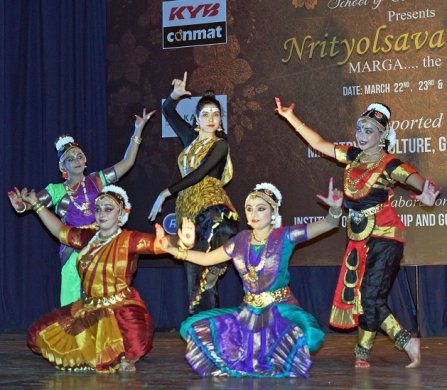 Shiva Tandava 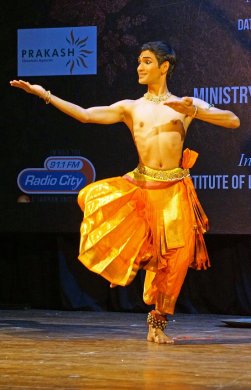 Avijit Das Kuchipudi by Avijit Das stole the show. This was for the first time I was seeing his Kuchipudi performance. Having studied Bharatanatyam from the young age of five under Sanaka Biswas at Shanti Niketan, he later joined Kalakshetra and obtained diploma in Bharatanatyam. He took training in Kuchipudi at Vempati Chinna Satyam's Kuchipudi Art Academy and went for further studies to senior exponent Manju Barggavee. Based in Bangalore, he is currently training under Jaikishore Mosalikanti. Performing to shlokas from Krishna Leela Tarangini, he dwelt upon Krishna leela, including episode of Kaliyamardana. Alokaya Balakrishnam sakhi goes the refrain. His movements were like lightning, and have a quicksilver quality emphasizing the typical movements of Kuchipudi. He is a powerhouse of energy. He has imbibed Vempati bani very well and highlights the salient features with finesse. The complicated movements of placing big toe of the feet one on another and moving forward, executing various gaits, Avijit displayed his mastery over the technique. Performing Tarangam dancing on the brim of a brass plate, he executed the mnemonics in a repartee to mridanga sounds matching it to the sounds of the brass plate. The clarity of sound and execution of talas won rounds of applause. Effortless execution of the adugulus of Kuchipudi was noteworthy. On 24th March, the tiny tots of Nrityodaya stole the hearts of the audience performing to a poem of Kavalam Panicker which has been a hit in a Malayalam movie. There is nothing filmy about it. The joyous dancing by some young children from the age of four to ten, without any stage fright, and dancing in unison was noteworthy for Ayswaria's patience in teaching children. From Guwahati, leading Sattriya dancer Sharodi Saikia, could unfortunately not come on final day on account of unavoidable circumstances. Dr Haripriya Nambudiri from Cochin presented Puthana Moksham in Kathakali. She is one of the bright female exponents who has won considerable fame for taking to Kathakali. Having been trained for more than ten years, though she started late when she was 22, giving up her job of a lucrative fashion designer, she decided to devote her time to learning Kathakali, even when there was quite an opposition to that. There have been many female Kathakali dancers, therefore her decision in spite of opposition in social media did not bother her. Performance after performance brought her critical acclaim and now she is busy performing in Kerala during the season. 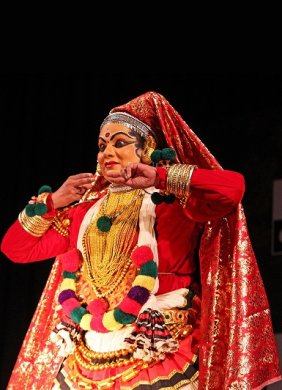 Haripriya Nambudiri That she is a gifted dancer was obvious when she enacted entrance of Puthana to Ambadi, Gokul in search of Vasudeva's house. Sent by Kamsa to kill Krishna, she visits Gokul in disguise as an attractive milkmaid. Her observations of milkmaids doing regular chores, churning butter and gossiping, peacock dancing in Vrindavan, musicians playing upon instruments, the way they check the tone and tune musical instruments, playing with perfection et al were danced beautifully. Seeing Vasudeva's house with several cows and fragrance of butter wafting from the direction of the house, she stealthily enters the chamber where Krishna is asleep in a cradle. Seeing Krishna's charming face, with motherly love she cajoles him, lifts him from the cradle and embraces. She continues to admire him and on remembering the assignment that she was sent to kill him, she curses Kamsa and blames herself. Then she picks up Krishna and after poisoning her breasts starts feeding him. She is happy as the child sucks milk from her breasts. But soon she starts feeling pain, her veins get tense, pain spreads all over her body; she tries to throw Krishna away who is sucking her life, beats him violently but does not succeed. Then with a cry she reveals her demonic form, her eyes blackened, her teeth protruding and her long black hair caught up in her teeth, utterly helpless she falls on the floor and dies. The entire episode was performed dramatically, keeping audience glued to their seats. With final falling on the floor, Haripriya received thunderous applause. Hers was a brilliant performance. 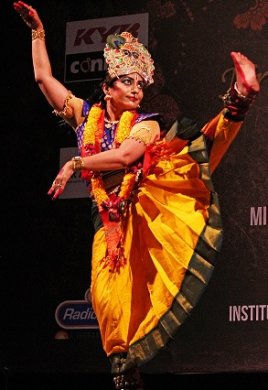 Smruti Vaghela 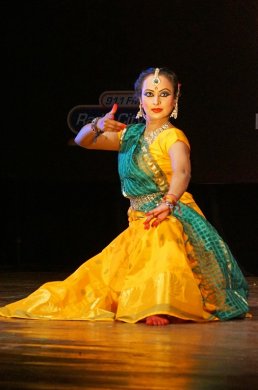 Anjana Jha Dr. Smruti Vaghela, a Bharatanatyam exponent from the Dance Department of M.S University of Baroda, was invited to present Srimad Bhagavad Gita. She has studied it under the guidance of Dr. Padma Subrahmanyam. Wearing a crown as Krishna, Smruti performed with agility, both the roles of Krishna and Arjuna. The text in Sanskrit, with several well-known shlokas from Gita, is used to show when Arjuna seeing his relatives does not want to fight in the battle of Kuruskshetra. Krishna then advises him and encourages him to fight. The shlokas like 'Yada Yada hi dharmasya glanir bhavati Bharata', Krishna advising Arjuna about his Karma 'Karmanyave adhikaraste, ma faleshu kadachana', 'yatha tyjati vasansi', then revealing his Vishwarupa, Krishna makes Arjuna pick up his Gandiva bow to start fighting. Padma Subrahmanyam is well known for the use of Karanas in her choreography. Smruti has incorporated some of them in her dancing. She performed both the roles of Krishna and Arjuna competently. The finale was by Jaipur gharana exponent Anjana Jha from Gwalior. Trained by Rajendra Gangani, she presented in Jhaptal intra-forms like chakkradar parans, aamad, tatkar, etc., highlighting Jaipur gharana Kathak. She was accompanied by her two students who are trained at Raja Tomar College at Gwalior. A few days ago, I had seen Anjana Jha at Pankaj Utsav at Bhubaneswar. She repeated Surdas pada for abhinaya. The Tarana in Bageshree raga was well executed. She, like majority of Jaipur gharana dancers, laid a lot of stress on chakkars. She would do well to balance her performances with additional abhinaya number besides Surdas bhajan. The three day festival ended with certificates given to tiny tots and other students to encourage them for their efforts. The Ministry of Culture, Govt. of India, the Institute of Leadership and Governance of M.S University, and few corporate bodies supported the festival. It is an important festival in Vadodara, as lesser known dance forms are featured offering opportunities to public to see the rich dance heritage of India.  Dr. Sunil Kothari is a dance historian, scholar, author and critic, Padma Shri awardee and fellow, Sangeet Natak Akademi. Dance Critics' Association, New York, has honoured him with Lifetime Achievement award. Post your comments Please provide your name and email id when you use the Anonymous profile in the blog to post a comment. All appropriate comments posted with name & email id in the blog will also be featured in the site. |